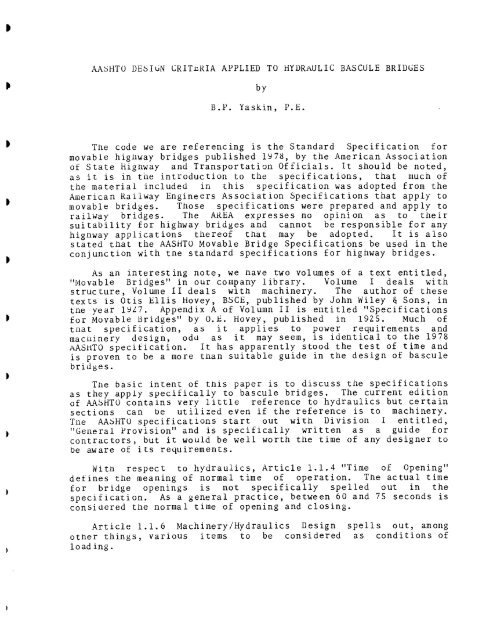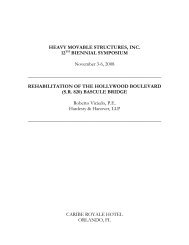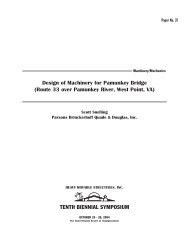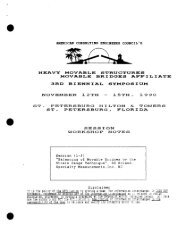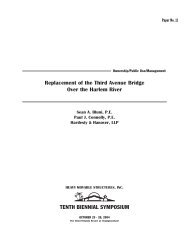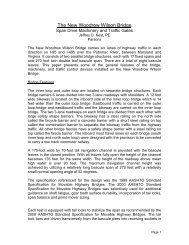AASHTO Design Criteria Applied to Hydraulic Bascule Bridges
AASHTO Design Criteria Applied to Hydraulic Bascule Bridges
AASHTO Design Criteria Applied to Hydraulic Bascule Bridges
You also want an ePaper? Increase the reach of your titles
YUMPU automatically turns print PDFs into web optimized ePapers that Google loves.
AASHTU DESIGN CRITcKIA APPLIED TO HYURxULIC BASCULE BRIDGESbyB.Y.Yaskin, P.E.The code we are referencing is the Standard Specification formovable highway bridges published 1978, by the American Associationof State Highway and Transportation Officials. It should be noted,as it is in tne introduction <strong>to</strong> the specifications, that much ofthe material included in this specification was adopted from theAmerican Railway Engineers Association Specifications that apply <strong>to</strong>movable bridges. Those specifications were prepared and apply <strong>to</strong>railway bridges. The AgEA expresses no opinion as <strong>to</strong> theirsuitability for highway bridges and cannot be responsible for anyhignway applications thereof that may be adopted. It is alsostated that the AASHTU Movable Bridge Specifications be used in theconjunction with the standard specifications for highway bridges.As an interesting note, we nave two volumes of a text entitled,"Movable <strong>Bridges</strong>" in our company library. Volume I deals withstructure, Volume I1 deals with machinery. The author of thesetexts is Otis Ellis Hovey, BSCE, published by John Wiley 6 Sons, intne year 1927. Appendix A of Volumn I1 is entitled "Specificationsfor Movable <strong>Bridges</strong>" by O.E. Hovey, published in 1925. Much oftnat specification, as it applies <strong>to</strong> power requirements andmacninery design, od~l as it may seem, is identical <strong>to</strong> the 1978xASHTO specification. It has apparently s<strong>to</strong>od the test of time andis proven <strong>to</strong> be a more than suitable guide in the design of basculebridges.Tile basic intent of this paper is <strong>to</strong> discuss the specificationsas they apply specifically <strong>to</strong> bascule bridges. The current editionof AA5HTU contains very little reference <strong>to</strong> hydraulics but certainsections can be utilized even if the reference is <strong>to</strong> machinery.Tile <strong>AASHTO</strong> specifications start out with Division I entitled,"General Provision" and is specifically written as a guide forcontrac<strong>to</strong>rs, but it woiild be well worth the time of any designer <strong>to</strong>be aware of its requirements.Witn respect <strong>to</strong> hydraulics, Article 1.1.4 "Time of Opening"defines the meaning of normal time of operation. The actual timefor bridge openings is not specifically spelled out in thespecification. As a general practice, between 60 and 75 seconds isconsiclered the normal time of opening and closing.Article 1.1.6 bfachinery/<strong>Hydraulic</strong>s <strong>Design</strong> spells out, amongother things, various items <strong>to</strong> be considered as conditions ofloading .
A) The effect of acceleration or retardation generally considered<strong>to</strong> be between 5 and 15 seconds. The obvious force hereis overcoming inertia.B) The effect of frictional resistance which generally consistsof the frictional resistance in the main trunnion bearing,the efticiency of the hydraulic system which should accountfor pressure losses in lines, fittings, and components.C) Any unoalanced condition of the bridge. It is generallyaccepted that some unbalance be required for basculebridges. This unbalance is normally <strong>to</strong> make the bridge noseheavy, thus requiring somewhat less force for closing and <strong>to</strong>provide a positive downward force at the live load shoe.For hydraulic cylinder this may also help even-out operatingpessure when co~riing down since the rod end of the pis<strong>to</strong>nyields a smaller area upon which <strong>to</strong> develop the <strong>to</strong>tal operatiunalforce.D) Wind loads for which three load conditions are generallyconsidered. A 2 1/2 pound wind used for the selection ofpower and design of hydraulic system <strong>to</strong> operate the bridgeIn tne normal time frame, 60-75 seconds. A 10 pound windused for selection of power and design of hydraulic system<strong>to</strong> operate the bridge in twice the normal time, 120-150seconds, and a 20 pound wind force used <strong>to</strong> establish maximumhydraulic pressure for holding the bridge in any position.Division I1 of this specification is entitled, "<strong>Design</strong>" and isdivided in<strong>to</strong> two groups, structural and machinery. Of interest inthe structural section is Article 2.1.11 entitled, "Impact". <strong>Hydraulic</strong>cylinders are supported by some part of the structure andwill be affected by the operating forces. This section requirestnat stresses in structural parts caused by the machinery/hydraulicor by forces applied by moving or s<strong>to</strong>pping the span, shall be increased100% as an allowance for impact.Article 2.1.12, "Fatigue", refers the designer <strong>to</strong> the basic designcriteria and allowable fatigue stresses as given by the currentedition of <strong>AASHTO</strong> Standard Specifications for Highway <strong>Bridges</strong>.Article 2.1.14 "<strong>Hydraulic</strong> Cylinder Connection". The stresseson the structural connecrion <strong>to</strong> the cyliners shall be based on acylinder pressure of 150 percent of the setting of the pressure-reliefvalve controlling the maximum pressure available at thecylinder.Continuing on in<strong>to</strong> the Machinery <strong>Design</strong> section - the designersfirst series of steps is <strong>to</strong> determine tne location and size of hydrauliccylinders and the following steps would thus be necessary:
1) Establish normal time for opening - 60-75 seconds.2) Establish the Maximum angle of opening generally 74 <strong>to</strong> 77degrees.3) Positioning of hyraulic cylinders. Obviously the firstchoice would be <strong>to</strong> locate hydraulic cylinders under maingirders. This would not be the only location available andin the case of bridge renovation where a hydraulic systemwere <strong>to</strong> replace a machinery system, other locations mayprove <strong>to</strong> be more suitable. The connection of the rod eye attne end of the pis<strong>to</strong>n rod via pillow blocks (bearings) <strong>to</strong>the main girder or structure should be located well belowtne trunnion and as far forward of the trunnion as is possible.The bot<strong>to</strong>m surface of the bot<strong>to</strong>m flange of the maingirder provides the designer with both these features. Thebasic object is <strong>to</strong> create a situation where the moment arm,being the distance between the pis<strong>to</strong>n rod and the center ofrotation (trunnion), is maintained at a maximum throughoutthe opening and closing process. This, in effect, will producethe minimal amount of operating force needed during theentire opening process. Cylinders can be supported on themachinery platform at the end with a clevis type device orat intermediate points between the bot<strong>to</strong>m and the <strong>to</strong>p of thecylinder. In effect, one consideration in determining theultiitiate length of the cylinder would be the stability ofthe cyli~lder and pis<strong>to</strong>n rod when fully extended. Theshorter the distance between the rod eye and the point ofsupport of the cylinder which would result in an overallshorter cylinder. In essence, the cylinder is made longerin order <strong>to</strong> leave the pis<strong>to</strong>n deeper within the cylinder whenthe pis<strong>to</strong>n rod is fully extended. The term for this is"s<strong>to</strong>p-tube distance", a distance added <strong>to</strong> the length ofstroke required <strong>to</strong> fully actuate the bridge. It has beenour finding that a center mounted trunnion cylinder providesthe best features for design. Supporting the cylinder <strong>to</strong>oclose <strong>to</strong> the <strong>to</strong>p also results in the need for a very accuratealignment between the vertical axis of the main girderand the horizontal positioning of the cylinders.4) At this point one should calculate or estimate the variousindividual load considerations as mentioned earlier, such asovercoming inertia, resistance in the trunnion bearing, efficiencyloss in the hydraulic system, unbalanced momentsdue <strong>to</strong> unbalanced load conditions, and the loads created bythe 2 1/2 pound wind, the 10 pound wind and the 20 poundwind.
Article 2.5.3, "Power Requirements and Machinery (<strong>Hydraulic</strong>)uesign" established specific load conditions and combinations forwhicu tne hydraulic system shall be proportioned and power provided.Condition A is tne combination of loads for normal time ofopening, the 60-75 second time frame. For bascule bridges the loadcombinations include the effects of frictional resistance, inertia,unbalanced load conditions and a wind load of 2 1/2 pounds persquare foot acting normal <strong>to</strong> the floor with the bridge in any position,for open decked grid floor bridges the floor area may be reducedby 15%.Condition B is the combination of loads for whicn an extendedtime of operation is allowed, specifically 1 1/2 times the nornaltime. This combination requires an additional 2 1/2 pounds persquare foot for ice loading be applied. In addition <strong>to</strong> those loadsspecified under condition A above. Obviously, this load conditionneed only be explored where ice is likely <strong>to</strong> be encountered.Condition C, again allowing for an extended time of operation,specifically twice the normal time, requires the following combinationof loads: Frictional resistance, inertia, unbalanced loadconditions, and a wind load of 10 pounds per square foot on anyvertical projection of the open bridge and an ice load of 2 1/2pounds per square foot. Again, the ice loading need only be appliedin areas where ice is anticipated. When calculating theactual time of operation, at no time should the wind loads be lessthan 2 1/2 pounds acting normal <strong>to</strong> the bridge as compared <strong>to</strong> the 10pounds per square foot acting on the vertical projection of theopen bridge.A brief discussion and consideration of electric mo<strong>to</strong>rs andpumps is important at this point. In most hydraulic applications asomewhat higher speed mo<strong>to</strong>r is generally provided than that usedfor the machinery design systems. It has been our practice <strong>to</strong>select an 1800 rpm mo<strong>to</strong>r. The hydraulic pump that we intend <strong>to</strong> usewill require horsepower control. With this pump the moni<strong>to</strong>ring ofhorsepower in terms of flow (gallons per minute) and pressure willbe provided. With this type of pump we will obtain au<strong>to</strong>maticstroking or ramping of the pump <strong>to</strong> insure that the combination offlow and pressure generated by the system will provide a uniformhorsepower output. Thus the mo<strong>to</strong>r is generally brought up <strong>to</strong> speedprior <strong>to</strong> energizing or stroking the pumps. With this mo<strong>to</strong>r pumpcombination the system has the ability <strong>to</strong> operate under a varietyof load combinations and the effect would be <strong>to</strong> regulate flow thusextending the time of operation. This feature is a perfect matchfor the <strong>AASHTO</strong> loading combinations in which, as the loads are increased,the times for operation are extended. . The followingseries of steps are suggested in sizing cylinders and selectingpower:
5) Would first require the calculation of the forces generatedby each of the three load conditions, A, B, and C. Generallyeach lift consists of two main girders and it is thereforeimplied tiiat a miniurn of 1 cylinder be required undereacll main girder. It has been our practice on the somewhatlarger bridges, that two cylinders be located under eachmain girder, or a <strong>to</strong>tal of 4 cylinders per leaf. This providesthe designer and the owner with the ability, duringrepair and servicing of cylinders, <strong>to</strong> remove one or even twocylinders and still have the capability of bridge operationunder normal loading conditions. We have generally foundthat load condition C will dictate the number of cylindersor size of cylinders that must be provided and by reviewingtne operating pressures developed for load condition A whentwo cylinders have been removed from the system will findthat operating pressures are within safe limits.b) Determine the <strong>to</strong>tal operating force generated by conditionA based on normal time of operation. This should be donefor both the opening procedure and for the closing procedureby calculating the surface area of the pis<strong>to</strong>n for allcylinders and dlviding that in<strong>to</strong> the opening force generatedone can determine the operating pressure required, andsiu~ildrly calculating the surface area on the rod side oftne cyllnder and dividing that in<strong>to</strong> the force required <strong>to</strong>close the leaf will generate the operating pressure that results.Generally operating pressures for normal time of operationshould be around 500-600 psi.7) Determine operating force, and tile pressures for condition Bwith an extended time of 1 1 /2 tne normal time in a similarfashion <strong>to</strong> 6 above, a pressure of approximately 1000 psiwould be appropriate.8) Determine operating force, and the pressures for condition Cwitn an extended time of twice the normal time in a simlarfashion <strong>to</strong> b above, a pressure in the range of 1500 <strong>to</strong> 2000psi.9) The next condition of consideration is the ability of thecylinders <strong>to</strong> hold the bridge in the fully open position forthe 20 pound wind force. Under this condition the maximumpressure of between 2500 and 3000 psi would be appropriate.10) Having calculated the various combinations of loads andcylinder pressures and thus determined the appropriate numberand size of cylinders, and having positioned them, ournext step would be <strong>to</strong> determine stroke length and verifythe time of operation for the various load conditions.Since loads and moment arms vary as the bridge
is opened and closed, the designer must calculate these fac<strong>to</strong>rsbased on small increments of opening. We have foundthe use of a computer <strong>to</strong> be very beneficial in making thecalculation since the computer can perform such calculationsfor eacli degree of opening in a very short time. This wouldallow tne designer <strong>to</strong> make the most optimum selection ofcylinder size arid horsepower required. With the proper programthe designer could input leaf dimensions, geometriclocat ions of trunriion, connection points of the cylinders,number of cylinders, size of cylinders, size of the pis<strong>to</strong>nrod, angle of opening under various loading conditions, hisestimate of horsepower required, the efficiency of the systell1and time for acceleration. Because of the rotation ofthe leaf the moment arm between the center of rotation andtne pis<strong>to</strong>n rod vary with each degree of opening and sincethe 10 pound wind load is applied <strong>to</strong> the vertical projectionof the leaf, the forces applied <strong>to</strong> the cylinder vary witheach moment of opening. With the computer program the designerwould analyze in one degree increments, all conditionsof loading, calculate the length of stroke, momentarm, forces required <strong>to</strong> push tne leaf up and pull the leafdown, pressures encountered, and time required <strong>to</strong> move theleaf through each degree of opening.Once the hydraulic cylinders, mo<strong>to</strong>r, pumps have beenestablished, various other components must be selected. Inorder <strong>to</strong> utilize the hydraulic cylinders as an effectivebrake in which the leaf can be held in any position, checkvalves are necessary and should be located as close <strong>to</strong>cylinder ports as is practical. In our case, pilot actuatedcheck valves are necessary so that when pressure isapplied <strong>to</strong> the cylinder at one port, the check valve at theother end is au<strong>to</strong>matically opened. Thus whenever the poweror pumps are shut-off the crleck valves au<strong>to</strong>matically closelocking fluid in cylinders and therefore results in holdingtile bridge in its current position. Relief valves are sonecessary that operating pressures do not exceed designliioitations. As we discussed, the maximum operating pressurefor load condition C would be in the range of 1500 <strong>to</strong>LUUU psi and we should therefore have at an appropriatelocation, a relief valve which is set <strong>to</strong> the maximum operatingpressure expected, and since the cylinders are <strong>to</strong> beutilized as brakes with the capability of withstanding theZu pound holding force, a second set of relief valves wouldbe necessary which would have a pressure setting ofsomewhere between 25UO and 3000 psi. The selection ofother components such as counter balance valves andfour-way directional valves, would be selected based on the
volume of flow. <strong>Hydraulic</strong> tanks should be sufficientlylarge enough <strong>to</strong> hold between 4 and 5 times the requiredvolume of fluid <strong>to</strong> operate the bridge during one cycle.This large volume of fluid is primarily used <strong>to</strong> dissipateheat, but certainly insures ample supply of fluid. Wherehydraulic systems are anticipated <strong>to</strong> be used a numerous numberof times in quick succession and it is likely that anexcessive heat build-up can be anticipated the need for aheat exchange should be provided. On the other hand, it maybe necessary <strong>to</strong> provide a heating element <strong>to</strong> bring oil temperaturesup <strong>to</strong> operating levels. This is generally necessarywhen hyraulic systems are first used on cold morningsor even continue <strong>to</strong> be used on cold days. Proper filtrationof hydraulic fluid is probably the most important item <strong>to</strong> beconsidered. The size of filtration and the location offilters is important. Fluid should be filtered just prior<strong>to</strong> returning <strong>to</strong> the tank. Fluid should be filtered prior <strong>to</strong>entering pumps <strong>to</strong> eliminate contaminates that might damagetne pumps unless pump designs are capable of handlingcontaminants without damaging the pumps, otherwise filtersshould be used just after pumps so as <strong>to</strong> preventcontamination of hydraulic components and cylinders.


